AMD A10-5800K & A8-5600K Review: Trinity on the Desktop, Part 1
by Anand Lal Shimpi on September 27, 2012 12:00 AM ESTCompute & Synthetics
One of the major promises of AMD's APUs is the ability to harness the incredible on-die graphics power for general purpose compute. While we're still waiting for the holy grail of heterogeneous computing applications to show up, we can still evaluate just how strong Trinity's GPU is at non-rendering workloads.
Our first compute benchmark comes from Civilization V, which uses DirectCompute 5 to decompress textures on the fly. Civ V includes a sub-benchmark that exclusively tests the speed of their texture decompression algorithm by repeatedly decompressing the textures required for one of the game's leader scenes. And while games that use GPU compute functionality for texture decompression are still rare, it's becoming increasingly common as it's a practical way to pack textures in the most suitable manner for shipping rather than being limited to DX texture compression.
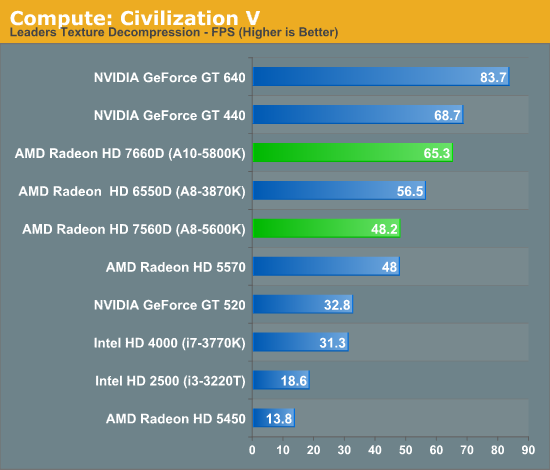
Similar to what we've already seen, Trinity offers a 15% increase in performance here compared to Llano. The compute advantage here over Intel's HD 4000 is solid as well.
Our next benchmark is SmallLuxGPU, the GPU ray tracing branch of the open source LuxRender renderer. We're now using a development build from the version 2.0 branch, and we've moved on to a more complex scene that hopefully will provide a greater challenge to our GPUs.
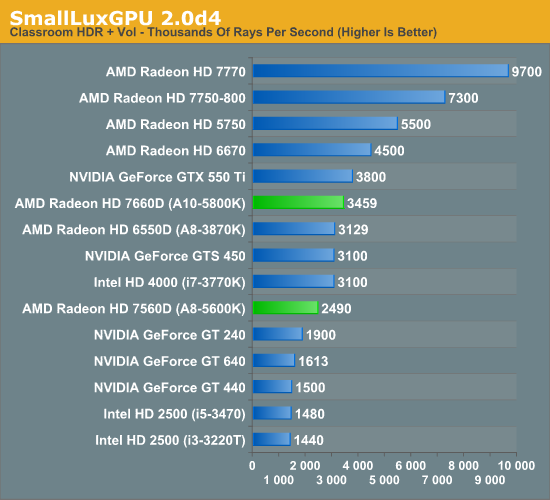
Intel significantly shrinks the gap between itself and Trinity in this test, and AMD doesn't really move performance forward that much compared to Llano either.
For our next benchmark we're looking at AESEncryptDecrypt, an OpenCL AES encryption routine that AES encrypts/decrypts an 8K x 8K pixel square image file. The results of this benchmark are the average time to encrypt the image over a number of iterations of the AES cypher. Note that this test fails on all Intel processor graphics, so the results below only include AMD APUs and discrete GPUs.
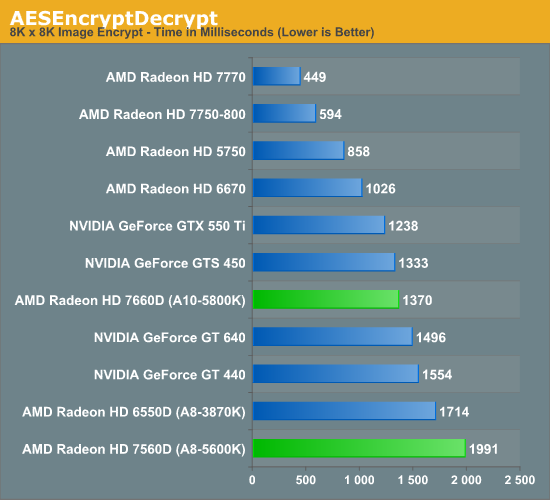
We see a pretty hefty increase in performance over Llano in our AES benchmark. The on-die Radeon HD 7660D even manages to outperform NVIDIA's GeForce GT 640, a $100+ discrete GPU.
Our fourth benchmark is once again looking at compute shader performance, this time through the Fluid simulation sample in the DirectX SDK. This program simulates the motion and interactions of a 16k particle fluid using a compute shader, with a choice of several different algorithms. In this case we're using an (O)n^2 nearest neighbor method that is optimized by using shared memory to cache data.
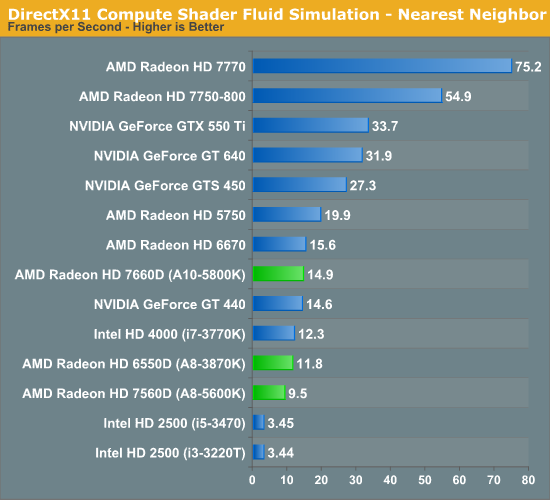
For our last compute test, Trinity does a reasonable job improving performance over Llano. If you're in need of a lot of GPU computing horsepower you're going to be best served by a discrete GPU, but it's good to see the processor based GPUs inch their way up the charts.
Synthetic Performance
Moving on, we'll take a few moments to look at synthetic performance. Synthetic performance is a poor tool to rank GPUs—what really matters is the games—but by breaking down workloads into discrete tasks it can sometimes tell us things that we don't see in games.
Our first synthetic test is 3DMark Vantage's pixel fill test. Typically this test is memory bandwidth bound as the nature of the test has the ROPs pushing as many pixels as possible with as little overhead as possible, which in turn shifts the bottleneck to memory bandwidth so long as there's enough ROP throughput in the first place.
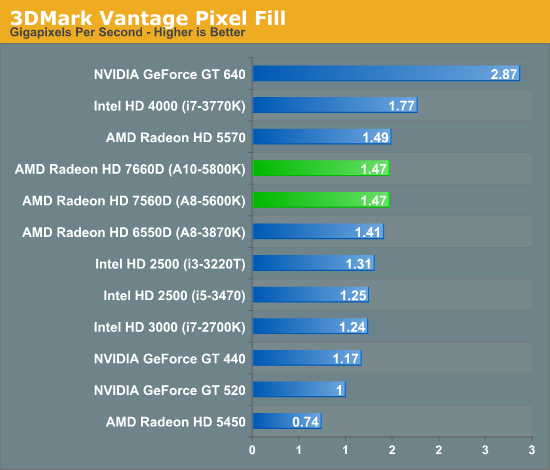
Since our Llano and Trinity numbers were both run at DDR3-1866, there's no real performance improvement here. Ivy Bridge actually does quite well in this test, at least the HD 4000.
Moving on, our second synthetic test is 3DMark Vantage's texture fill test, which provides a simple FP16 texture throughput test. FP16 textures are still fairly rare, but it's a good look at worst case scenario texturing performance.

Trinity is able to outperform Llano here by over 30%, although NVIDIA's GeForce GT 640 shows you what a $100+ discrete GPU can offer beyond processor graphics.
Our final synthetic test is the set of settings we use with Microsoft's Detail Tessellation sample program out of the DX11 SDK. Since IVB is the first Intel iGPU with tessellation capabilities, it will be interesting to see how well IVB does here, as IVB is going to be the de facto baseline for DX11+ games in the future. Ideally we want to have enough tessellation performance here so that tessellation can be used on a global level, allowing developers to efficiently simulate their worlds with fewer polygons while still using many polygons on the final render.
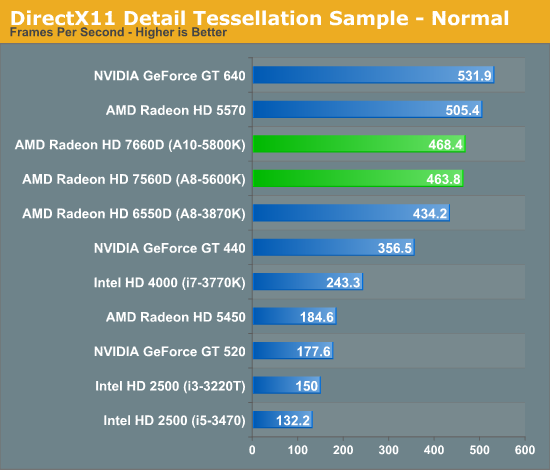
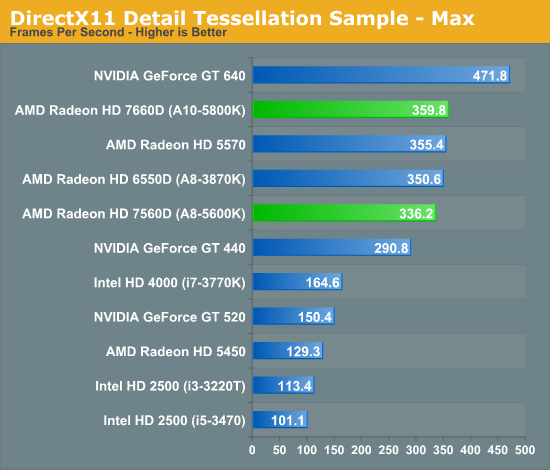
The tessellation results here were a bit surprising given the 8th gen tessellator in Trinity's GPU. AMD tells us it sees much larger gains internally (up to 2x), but using different test parameters. Trinity should be significantly faster than Llano when it comes to tessellation performance, depending on the workload that is.










139 Comments
View All Comments
ganeshts - Thursday, September 27, 2012 - link
Yes, they can be used simutaneouslymikato - Monday, October 1, 2012 - link
Eyefinity!MrSpadge - Thursday, September 27, 2012 - link
Seeing how the A10-something has 1.5 times the raw GPU horse power than the A8-something it seems obvious that the A10 is badly choked for memory bandwidth, even at DDR3-1866. Since even DDR3-2400 ist rather cheap these days it would be interesting to see performance scaling with memory speed. I expect the value the A10 provides can be considerably increased.rscoot - Thursday, September 27, 2012 - link
Wondering if the IMC is rated for DDR3-2400 though. And yeah it's patently obvious that the APU on these chips are starved for memory bandwidth.wwwcd - Thursday, September 27, 2012 - link
Intel HD 4000, looks like a wrist of gay, against the presentation of graphics controllers set in Trinity ;)formulav8 - Thursday, September 27, 2012 - link
This preview showed me how pathetic Intels junk is. Doesn't even come close overall.Aone - Thursday, September 27, 2012 - link
Would you say what cpu you used for GT 640?wheeqo - Thursday, September 27, 2012 - link
AMD please take Trinity to Windows 8 Tablet!Roland00Address - Thursday, September 27, 2012 - link
but is it possible for you to add these three cards before the final review next week1) 6670 1gb gddr5
2) 6570 ddr3 or 6670 ddr3
3) 7750 1gb gddr5
I ask for these are new cards that trinity will be competing against in a similar price bracket. You can't find a 5570 on neweeg right now since it has been discontinued and replaced with 6000 and 7000 series part. The only 5570 on newegg right now is a proprietary one from visiontek with a custom output that has a dongle that allows it to do 4 monitors in a low profile slot.
Thank You
herrdoktor330 - Friday, September 28, 2012 - link
To add on to this one, can you test the APU with those cards IN CROSSFIRE?I seriously think that you could get decent enough HD gaming from this setup with some eye candy with a little help from a discrete GPU. I've been waiting on this platform for a while and, while the CPU performance will be similar to the mobile variant (thus underwhelming), this APU is going to be awesome for the HTPC that's also gaming capable.